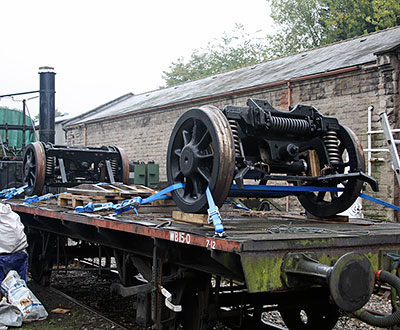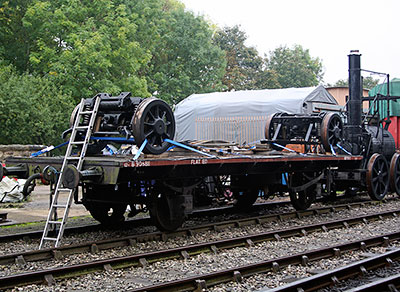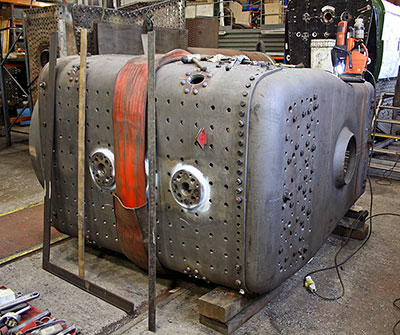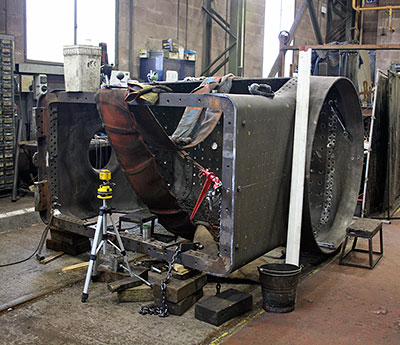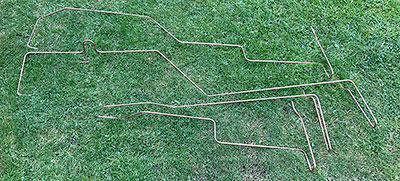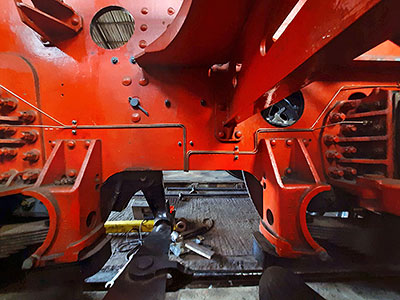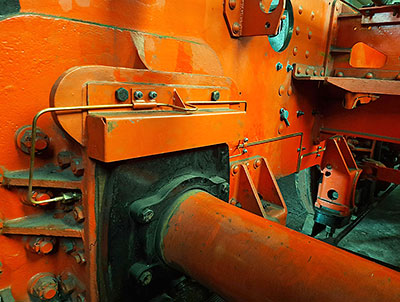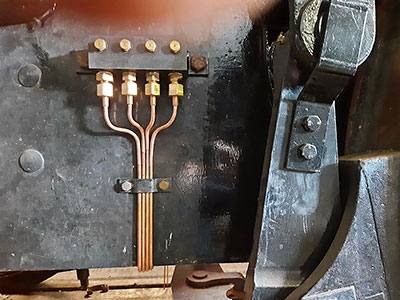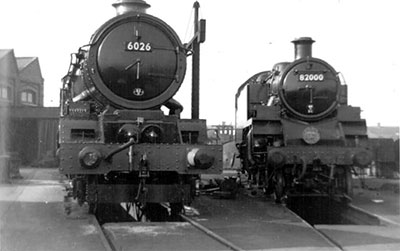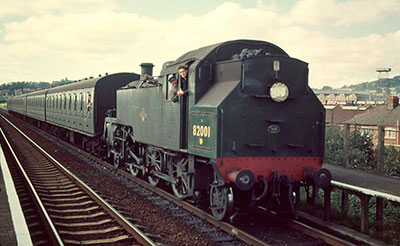
News Update - October 2021
Engineering notes
By Tony Massau
The two pony trucks were loaded on to a flat wagon with the aid of the JCB on 18th. October and once secured were shunted to the loco yard by the class 08 diesel shunter. An opportunity is now awaited for the wheeldrop to become available when the pony trucks can be fitted under the chassis of 82045. We had originally hoped to have reached this stage many months ago but coronavirus lockdowns conspired against us.
Grease lubrication pipework is being installed to the horn guides of the coupled wheels. As with so many jobs there is more to this than might be casually thought when one studies the somewhat tortuous route that these pipes follow which involves much measuring, bending and checking of the various pipes to achieve a neat and satisfactory result.
Plugs are being fitted to the piston heads and some further machining of boiler water level gauge components is taking place.
Some further progress has been made with assembly of the rocking grate mechanism.
Refreshing of the paintwork on the loco continues.
Firebox work continues. The pads for the manifold and safety valves are riveted and seal welded in place. The mud door doubling plates are riveted in place.
ANNUAL GENERAL MEETING
By Chris Proudfoot
I think this is our fourth attempt to have a proper AGM, but please make a date in your diary for Saturday 2nd April 2022 at 14.00, venue the upstairs Lecture Theatre at Kidderminster Railway Museum. Please keep everything crossed that we might actually manage it this time!
82XXX IN BR DAYS
Well, our members have certainly come up with the goods yet again, following last month's images of 82029 and 82020. I received a number of very knowledgeable emails - thanks very much to all those who wrote to me.
Re 82020, Stuart Brown wrote:
"The shot of 82020 brings back memories. We were holidaying in Llwyngwril, North Wales, about 1965-ish and this engine was a regular on the Pwllheli section. Dad was an ex-LNER man, but struck up a rapport with the regular driver. After a trip up to Porthmadog and a ride on the Ffestiniog (in the pouring rain), we got off at Minffordd for the return trip to Llwyngwril on the coast line. The train was packed and we had to stand in the corridor. At Barmouth the fireman came looking for us and said that as they'd had a clean-up on the footplate, the driver wanted up to ride with them. I was installed in the fireman's seat whilst Dad stood behind the driver. The fireman stood with his back to the firehole door and I have a vivid memory of steam from his wet overalls being sucked into the firehole as we crossed the Barmouth bridge. The climb up to the Ffriog avalanche shelters was heavy going, and the ride was appalling as the floor vibrated badly and coal poured out of the bunker all over the floor. No wonder they had had to have a clean up before we got on. I didn't enjoy it much either. Still, looking back, I was a lucky 12-year-old to get a footplate ride over such an iconic section of line. It was definitely this engine, though not as clean as in your photo."
[Sounds as though 82020 was in a pretty run-down state by 1965!]
Re 82029, I had this fascinating email from Peter Martin:
"Mention of 82029's final fling on Saturday July 8th 1967 has prompted me to contact you as I travelled on the train.
"82029 was a last-minute substitute for 80015 and as a result, the train left Waterloo about 25 minutes late. There was a six-minute stop for water at Woking and we arrived at Basingstoke at 09.02. The locomotive took water again there before continuing to Salisbury but I left the train at Basingstoke to continue my planned itinerary. During the afternoon I visited Salisbury shed and found 82029 in the shed yard.
"The September update reports this journey as 'a Wagnerian last stand on the final day of Southern steam'. It is still an event I recall clearly, and I hope you won't mind my pointing out two errors on the reporting of the working....Firstly, it was a passenger train on the penultimate day of Southern steam, not a parcels, as reported in the recent update. Secondly, in the History section of the 82045 website there is mention that 82029 left the train at Basingstoke and 'was moved on to the mpd'. This is not the case and I feel that the website should be corrected to record this significant swan song of the class accurately."
This is really good stuff, Peter - thanks so much! I will ensure that the facts are correctly reported on the website: I need to do an update anyway, so will include your account in the modifications. I will incorporate some or all of the photographs you sent me in our November updates.
CORRECTION FROM SEPTEMBER MEMBER'S NEWSLETTER
On the subject of corrections - I'm always pleased to be put right, by the way - our colleague David Tyreman tells me that five 82XXX went to Patricroft towards the end of their lives: in addition to nos 82000/03/31 and 82034, 82009 was also sent to the Salford shed. David also pointed out that 'The Cotton Spinner' of April 16th 1966 was an LCGB, not RCTS, special. Of course, if I'd looked more carefully at that nice shot of 82003 at Buxton, I'd have seen the letters LCGB displayed quite clearly on a plate on the top lamp bracket!
Thank you all, gents.
Now for two more shots for you...
The pony trucks on the flat wagon ready for movement to the loco yard. Photos: Tony Massau
Two photos of the outer firebox. Photos: Tony Massau
Various pieces of the grease lubrication pipes laid out on John's lawn showing the complex shape of the pipes. Photo: John Pagett
The pipes in position inside the loco's frames going to the horn guides. Photos: John Pagett
Finally the pipes neatly attached to the grease gun attachment manifold. Photo: John Pagett
A brand new nicely produced video from the SVR outlining the 82045 project.
Tony Massau and Ivan Whitehouse both sent me this interesting comparison of steam locomotive front ends: 82000 shares Swindon Works yard with 6026 King John, both engines looking pristine and ready for the off.
The photograph was taken by Reece Atkiss on 14th October 1956. The best part of three decades separates these two locos, and it is sobering to reflect that 82000 outlived the older engine by only four years. The 'King' was withdrawn in September 1962, the tank in December 1966, aged 32 and 14 respectively. Thank you to Reece, who sent the pic to Tony and Barbara.
My colleague from my SMF days, Ian Marshall, has sent me this nice shot of 82001, taken by his Dad, Brian, in 1963. Ian writes:
Well, never mind what he writes: can anyone identify the location? All will be revealed next month!
